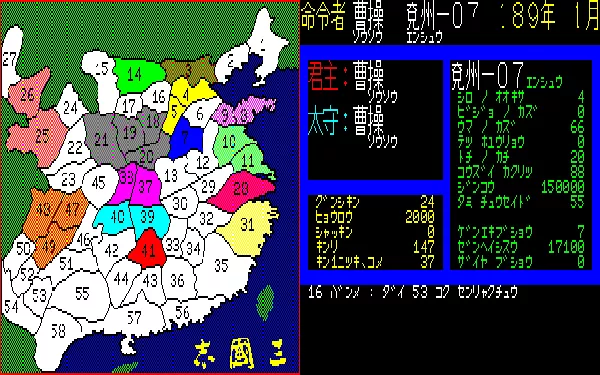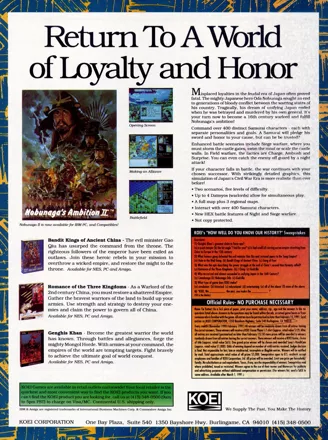Romance of the Three Kingdoms
Description official description
Based on the events of the Three Kingdoms era in China (3rd century), and on Luo Guanzhong's famous novel Sanguo Yanyi, the game casts the player in the role of one of the many warlords rivaling for control after the Yellow Turban Rebellion.
This turn-based strategy game introduces hundreds of historical characters of the Three Kingdoms era. The game's main objective is to become the supreme ruler of the remnants of the falling Han Dynasty. To do this the player has to build a mighty empire by conquering provinces and recruiting generals worthy of command. Fight massive battles, triumph over natural disasters and capture enemy strongholds.
Spellings
- スーパー三國志 - Japanese SNES spelling
- 三国志 - Japanese/Simplified Chinese spelling
- 三国志 for WonderSwan - Japanese WonderSwan spelling
Groups +
Screenshots
Promos
Credits (NES version)
| Producer (uncredited) | |
| Music Composer (uncredited) |
Reviews
Critics
Average score: 72% (based on 10 ratings)
Players
Average score: 3.8 out of 5 (based on 43 ratings with 3 reviews)
It wasn’t good then, and it isn’t good now.
The Good
The exotic setting of Romance is undoubtedly one of the reasons why this series has lasted so long. There just isn’t much competition in the field of “East Asian historical empire simulations.” Heck, there isn’t much competition from other strategy titles on consoles, either. I imagine that some folks will find the whole subject fascinating, even if they don’t know much about Chinese history.
The manual is typical Koei fare, which is to say that it’s quite thick and detailed by console-game standards. The historical background section is absolutely essential, considering that most Westerners will not know a single character in this game.
I actually liked the music. It’s not as good as the music in Genghis Khan or Nobunaga's Ambition, but it is appropriate and sounds pretty good considering the hardware limitations. Any 8-bit game soundtrack that doesn’t make you hit the mute button immediately must be considered a triumph.
In terms of gameplay, there were a few intriguing concepts introduced in Romance. The design takes advantage of the large cast of characters by making personnel management more important than in most other strategy games of this era. Not everyone will like it, but it does give Romance an RPG-like twist.
The Bad
I made the huge “mistake” of discovering Romance after I had already played two of Koei’s other 8-bit titles (Genghis Khan and Nobunaga’s Ambition, which are both very good). Romance is surprisingly primitive and shallow compared to those games, which made playing Romance a chore even back in the year 1991, not to mention 2008. Were it not for this game’s inherent appeal to Far Eastern gamers, I seriously doubt this series would have continued past the first title. This first one left such a bad taste in my mouth, I still haven’t played any of the numerous sequels to this day.
The menus are very clunky and unattractive, even by the standards of the era. I don’t mind text-based games, but the menus need to be laid out a little better than this! Numerous unnecessary and redundant messages will also pop up when you take any kind of action, which slows things down considerably.
In fact, the whole game moves at a painfully slow pace. Turns take a really, really long time. There are over 50 provinces, and the statistics in this game (gold, rice, troops, etc.) are numbered in tens of thousands, not hundreds as in Genghis Khan and Nobunaga. The NES CPU seems to have a very difficult time processing all of this data as a result.
Battles are very typical of the overall design. There is no strategic combat option. Like it or not, you are forced to play out the battles, which turn out to be rather boring. You have few tactical options, since units are not differentiated by type (i.e., cavalry vs. infantry) and the simultaneous attack method adds very little. Oh, and there is one incredibly annoying “feature.” When you invade another territory, you have to bring rice along with you and place it on the field of combat. You have to protect this rice, or else the battle is automatically lost. So even when you are on the offense in this game, it forces you to play from a defensive posture. Ugh.
And since this is supposed to be a game, I have to ask: Did it ever occur to Koei to include any “fun stuff” in the design? Where are the dirty tricks? Where are the exotic trade goods to buy and sell? What about character development? They aren’t here, and they really need to be, because this game is dull as dirt without them.
The Bottom Line
Arcane and obtuse, you won’t find much romance (or anything else very interesting) in the first installment of the Romance series. For 8-bit console strategy, virtually any of Koei’s other games would be a better choice.
NES · by PCGamer77 (3152) · 2008
Very, very strategic and engrossing!
The Good
I loved the God like quality the game gave you. This is an early sim type game, where you literally lord over your land and use your smarts to build up your empire. I love the complexity and challenging way the game makes you think.
“Should I spend more on my troops this season?”
“How many men should I train for the army?”
“Where should I place my armies?”
“Which province should I attempt to make an peace?”
“Should I guard against floods this season?”
“Who should lead my army?”
These are only a very, very small handful of questions you are asked to find answers to, and your decisions can literally cost you the game! It is addictive, very compelling.
You are never quite sure if you did the right thing, or for that matter, the wrong thing, as you might not discover your error until another season, or two. For example, if you didn’t prepare enough for the floods, or perhaps are betting against them, you might not find out for a few turns when suddenly there is a flood or fire in your northern province. The results of your smallest actions could, in time, balloon into a threat to your very existence! Rule wisely indeed!
The Bad
This game is VERY text based. There is very little in way of graphical play, other than movement of players, grain, armies, messages, money etc. over the maps. You have an option of watching the battles or simply being told the outcome.
Of course the reason for this is made very obvious the first time you ever play with the option to watch battles! The game slows down to an absolute snails pace because you have to witness every single attack and counter attack, and in every single province that you and/or the AI choose to fight in. If the game has a lot of scattered provinces with many rulers, like in the beginning rounds of play, it bogs down incredibly. Best to choose NO to watching battles! Trust me, otherwise you’ll be playing this until the end of time!
That kink in it’s armor is another annoyance, yes it’s text based, but it would be fun to watch some battles, join in the carnage, but you can’t really, and so it’s all texts and messages and questions and more texts! OY!
This game is very complex and there are hundreds of choices to be made, and it can get very tedious simply buying rice, selling rice, training troops, spying on neighbours, grooming generals, allocating rice and monies etc. etc. etc.
The Bottom Line
A very deep, rich game with countless hours and hours of play. Lots of text to read, lots of decisions to be made, but that's the life of a depot or Emperor. Fun simulation type game and LOTS of replay value, with a ton of variation. A game for thinking.
NES · by Oblio (97) · 2006
Thankfully in this series, the first was the worst.
The Good
Well, this game really started it all. Since there wasn't much else to compare it with back then, it was an "alright" game.
Why was this game so popular back then? Beats me. The game as I said was alright, but what made this game what it is is not because of the game itself, but more about the storytelling about the legend.
When KOEI made this game, it wasn't just a strategy game - it was a history lessen and flashbacks to ancient China. They really did some major research into the history of Sam Kok (Romance of the Three Kingdoms). While the game itself was alright, the manual was a treasured item to behold.
The manual consisted of detailed stories and information on each Chinese hero during the struggle, describing the overall drama between Liu Bei, Cao Cao and Sun Ce. Japanese and European medieval history would have trouble keeping up the epics Romance of the Three Kingdoms had to offer. I would say the reason why gamers like me kept on playing this particular game is because we got "connected" with the various characters involved in the game. We chose our leaders based on what ideals they lived by in history and "borrowed" their ideals for our own. Games like Romance of the Three Kingdoms is a rare historical role model where the overall "aim of the game" isn't just destroy everything in sight, seek and destroy or shoot'em all, it's a strategy game that although isn't directly represented in the game, tells the story about a bunch of lads that believe in honor, valor, loyalty and friendship, strong enough to band and forge one of the mightiest nations in the world.
The Bad
Uh...why does everyone have to die in this game? Not that it's not real, it's just that everytime a plague comes along, which it often does, your officers die on you like flies. For a couple billion Chinese blokes, it dang hard to keep your officers alive...if reality followed this game, there'll be only a couple hundred Chinese left, since the rest died from plague and disease.
The Bottom Line
The stepping stone for the "better versions" of Romance of the Three Kingdoms.
DOS · by Indra was here (20735) · 2003
Trivia
Awards
- Computer Gaming World
- October 1989 (Issue #64) –Strategy Game of the Year
Analytics
Identifiers +
Contribute
Are you familiar with this game? Help document and preserve this entry in video game history! If your contribution is approved, you will earn points and be credited as a contributor.
Contributors to this Entry
Game added by Indra was here.
Amiga added by JRK. Sharp MZ-80B/2000/2500, FM-7, Sharp X1 added by Infernos. Windows added by Sciere. Sharp X68000 added by Kabushi. MSX added by Martin Smith. PC-88, NES, PC-98, WonderSwan added by Unicorn Lynx. J2ME added by Jeonghyun Park.
Additional contributors: Unicorn Lynx, Opipeuter, monkeyislandgirl, Patrick Bregger.
Game added May 4, 2003. Last modified January 5, 2025.






















